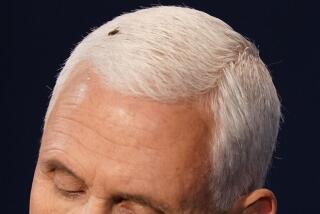‘ROSE BIRD DEBATES’--MORE NOISE THAN SENSE
“From Rose Bird,” said Jerry Dunphy, “let’s turn our attention to the Rose queen.”
Well, why not? This was TV--the Rolodex of headlines--wasn’t it? And these were “The Rose Bird Debates” at 4, 5 and 6 on KABC Channel 7’s “Eyewitness News,” this week’s heavily pitched Tuesday-through-Friday squabbles that often trivialized the California Supreme Court and its embattled chief justice.
What a perfect addendum to the political season, the silly season, the grubby season.
At about 45 minutes after the hour, a Bird supporter and a Bird critic have clashed for 6 to 11 minutes (not counting a commercial break) in a free-wheeling format.
The first two days’ revolving foes were, on the Bird side, attorney Howard Gillingham; Loyola law professor Allan Ides; Deputy Dist. Atty. William Holliman and Channel 7 commentator Bill Press, and on the opposing side, Rep. Bobbi Fiedler (R-Northridge) and Channel 7 commentator Bruce Herschensohn.
Was it good TV? Usually. Was it good information? Rarely.
Yes, the debates cried out for a moderator, although Dunphy occasionally tried to provide some guidance.
Yes, Channel 7 anchors should have been informed enough to correct disinformation during or after the debates a la ABC’s Ted Koppel on “Nightline.” The purpose of a newscast is information, not deception.
Yes, Fiedler got an unfair edge when a picture of 2 1/2-year-old murder-victim Amy Sue Seitz appeared on the screen, punctuating Fiedler’s attack on Bird’s participation in death-penalty reversals. It apparently was an honest mistake on the part of Channel 7. Fiedler’s people reportedly were able to convince the director to air the picture without the knowledge of the station’s debate coordinator.
And yes, Channel 7 President and General Manager John Severino’s anti-Bird editorial should not have been inserted shortly after the final Wednesday debate, in effect granting Bird blasters that evening’s final clobber.
There was a more fundamental reason, though, why the debates made more noise than sense.
With their emphasis on personality and performing skill, all TV debates are designed to be entertaining first, enlightening second. Whether the debaters are presidential candidates or smaller fry, the battle inevitably obscures the issues. TV debates reward camera craft, not brain craft, fast talkers, not smart talkers.
“The Rose Bird Debates,” in effect, were extensions of those goofy promos that Channel 7 is running advertising the wide political gaps separating the conservative Herschensohn and liberals Press and John Tunney, the former Democratic senator Channel 7 sometimes deploys as Herschensohn’s foil.
The dramatically lit spots show either Herschensohn and Press or Herschensohn and Tunney differing on issues and jawing and snarling at each other nose to nose. Then an off-camera voice declares: “One of them is crazy. You decide which one.” Just one of them?
The best of the “The Rose Bird Debates” was Tuesday’s relatively calm, reasoned Ides-Herschensohn clash. An hour later, though, Press easily out-shrilled Fiedler, and on Wednesday, personal attacks prevailed.
On the 5 p.m. newscast, for example, Herschensohn demanded to know Gillingham’s position on the death penalty, as if California voters were weighing Gillingham’s confirmation, not Bird’s.
On the 6 p.m., meanwhile, Ides charged Fiedler with being “blinded by your ideology.” She responded by charging Ides with being “blinded by your ideology.” On the other hand, perhaps Ides was blinded by Fiedler’s ideology, or maybe Fiedler’s ideology was blinded by Ides’.
If nothing else, though, “The Rose Bird Debates” have been meatier and more honorable than the squalid bumper stickerese of the political commercials tainting this season’s campaigning. Those 30-second hiccups are too brief to examine issues, but long enough to mislead if not outright lie.
In much of Europe, free TV time is granted equally to all political parties. In the United States, though, about the only route to office leads directly through paid political ads.
TV can make and remake candidates, even reluctant ones. There in her own TV spots is Bird, the former dowdy jurist now chicly blond-blown, glamorized and telegenic for the camera. Her looks have nothing to do with her controversial performance as chief justice, but apparently a lot to do with her TV performance as a candidate.
That is benign imagery, though, compared with the opposition’s manipulative TV ad in which Marianne Frazier sits beside a picture of her murdered 12-year-old daughter Robin, while urging the defeat of Bird and associate justices Cruz Reynoso and Joseph R. Grodin. The first conviction and death sentence of Robin’s killer was reversed in an opinion written by Grodin and signed by Bird and Reynoso, on grounds that testimony about his prior criminal record should not have been introduced at his trial.
The smut has really hit the fan in the 30-second spot war between Democratic Sen. Alan Cranston and the Republican who wants his job, Rep. Ed Zschau.
One pro-Cranston ad has attempted to tie Zschau to ultra-conservative support for South Africa’s white-supremacist government, even though Zschau has criticized that government and endorsed limited sanctions. Another pro-Cranston spot has depicted Zschau as repeatedly voting in Congress “with the Arabs,” as if anything Arab were automatically evil.
Zschau’s own recent TV ad campaign, meanwhile, accuses Cranston of being soft on terrorism and drugs. Two Zschau spots charge that Cranston has “missed or voted against virtually every tough law” on terrorism and drug enforcement in 18 years. However, that is untrue, an earlier Times story pointed out.
The most controversial--and shoddy--Zschau spot realistically duplicates a newscast, with a white-haired actor portraying an anchorman delivering this “news” flash:
“In Washington, despite an overwhelming vote by the United States Senate to impose the death penalty for drug pushers who willfully murder, California Sen. Alan Cranston voted ‘no.’ ”
Everyone should vote “no” to this kind of advertising. Even with an accompanying disclaimer--and further disclaimers added by protesting stations--the ad still probably left an impression with at least some viewers that this was an actual newscast. And that, after all, was the idea.
There’s no incentive for candidates to soften their TV ad tactics. Only when underdog Zschau got tough, for example, did he get going, with the latest polls show him dramatically slicing Cranston’s lead.
“Negative advertising works,” political consultant Paul Maslin noted on ABC’s “World News Tonight” Wednesday. The thrust of the ABC report was that office seekers no longer can count on being sold on TV like toothpaste. They can be sold on TV only by smearing their opponents. That, more than anything else, is a sad and revealing prospectus on the American voter in 1986.
From Rose Bird to Rose queens, image is what counts.
More to Read
The complete guide to home viewing
Get Screen Gab for everything about the TV shows and streaming movies everyone’s talking about.
You may occasionally receive promotional content from the Los Angeles Times.






